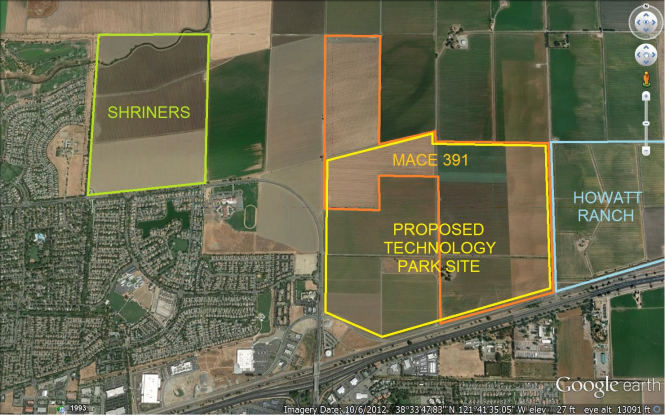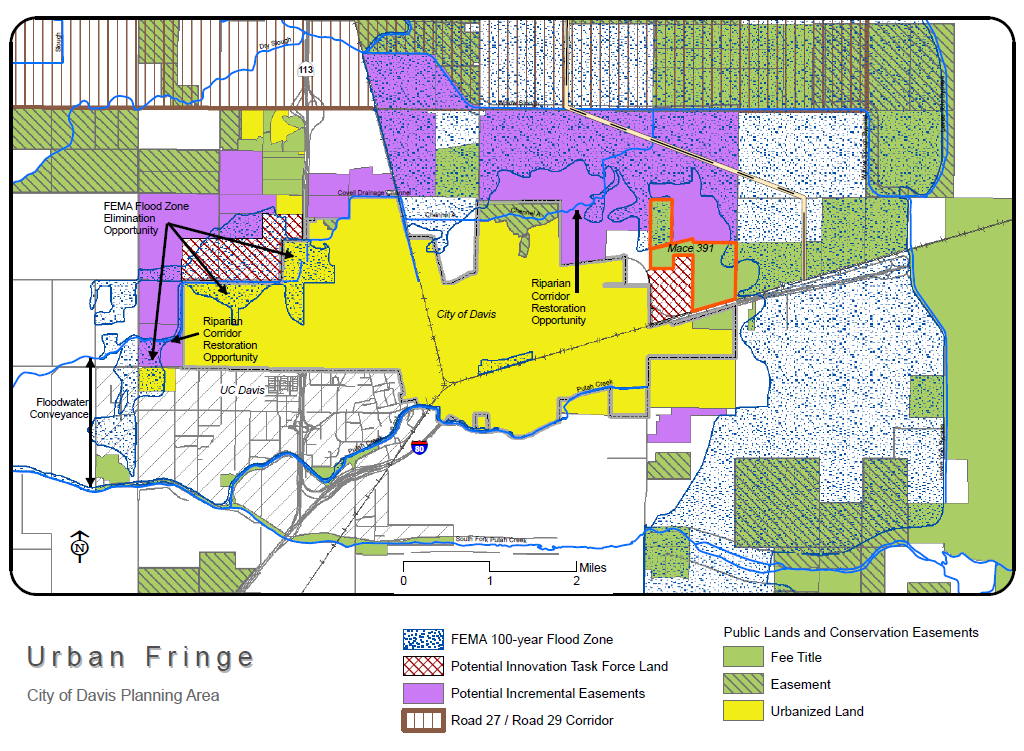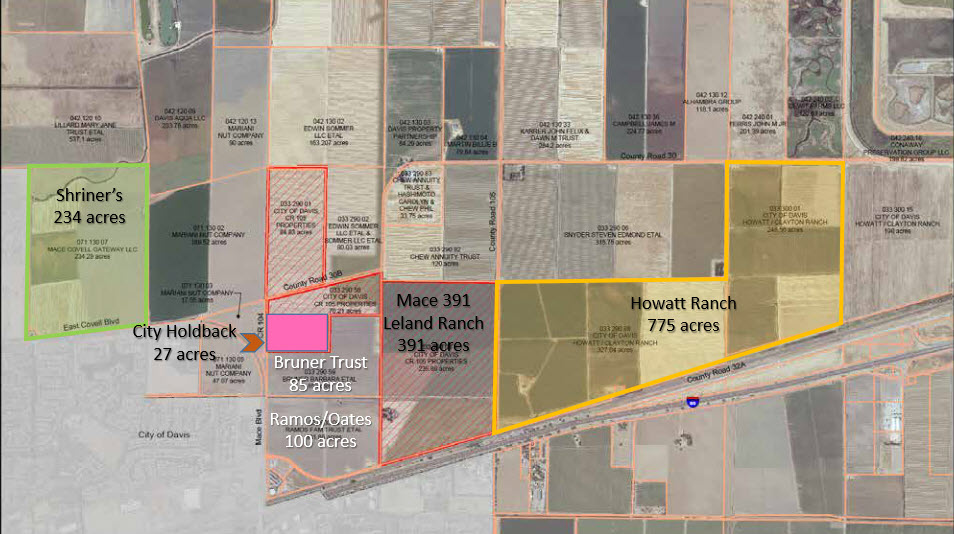 The discussion over Mace 391 has much larger ramifications than simply what the city does on that site. In a very real way, it frames the way the city handles land use policies going forward.
The discussion over Mace 391 has much larger ramifications than simply what the city does on that site. In a very real way, it frames the way the city handles land use policies going forward.
One of the key variables in the Mace 391 deal was the idea that the city would be able to develop a parcel of land, Mace 391, as a business park, while at the same time being able to secure other key areas of land such as the Shriner’s Property as a permanent easement.
For a number of years, the city of Davis has used three primary land use policies to protect its borders from peripheral development. The most recognized have been Measure J and Measure R, requiring a vote of the people any time that land zoned for agricultural uses is converted to urban usage.
We have also gained some understanding of Measure O, which has been under-utilized as an effort to capture farmland and protect that farmland as open space.
Finally, there is the pass-through agreement. The pass-through agreement was first agreed to in November 1987 following the debacle at Mace Ranch in which the city was forced into a compromise position when the county agreed to allow a developer to develop land just outside of the city.
The pass-through agreement allowed the city of Davis to pass-through roughly $2 million a year in redevelopment money in exchange for the county not approving urban development over the objections of the city.
The loss of redevelopment money for the city means that the city will no longer be able to continue the $2 million per year pass-through payments to the county.
In the short-term, this is not going to be a huge problem for the city. Back in 2007, Yolo County made the mistake of attempting to study key lands outside of Davis, including areas along the I-80 corridor, Covell Village, and the Northwest Quadrant.
The effort at that time was led by Supervisors Helen Thomson and Mariko Yamada. However, the discussion itself triggered hundreds of Davis residents showing up at the County Board of Supervisors meetings in protest to putting areas of the Davis sphere of influence into study areas.
Ultimately, the county backed off. The Davis area supervisors were replaced by Supervisors Jim Provenza and Don Saylor, who were much less inclined to develop areas outside of Davis – at least from a county perspective.
In the near term, there seems little danger that the county is going to propose housing near Davis. Moreover, as the county looks for revenue, they are more likely to favor economic development projects which can produce revenue, while housing projects are generally seen as revenue-neutral, if not a net revenue loss.
At the same time, while the loss of the pass-through agreement will not result in short-term development on Davis’ borders, there is no guarantee into the future that this will continue.
While many clamored for the city to re-examine Mace 391 as a spot for a business park, the current arrangement is not necessarily the worst situation in the world, from a land use perspective.
As the city’s land use map shows, the city has an improved position in the critical area along I-80. The Mace 391-Leland Ranch property is moving toward permanent ag easement status. If the effort for a business park moves to the west, to the Bruner and Ramos/Oates tracts, the city would already have an easement to the east in Mace 391, and it owns the Howatt Ranch property along I-80 and holds properties north of Bruner.
In addition, while the Mace 391 property would have swapped an easement at Mace 391 for one at Shriner’s, there is word that ownership of Shriner’s may change hands to a landowner interested in keeping that area undeveloped.
While the pass-through agreement became an effective tool to allow the city of Davis to control land use around its own periphery, as we move forward, the loss of the pass-through agreement may be less catastrophic than many have feared for the last decade.
What the city needs to do is as we have been suggesting. One approach is, as we have suggested, a new General Plan that can identify potential places where the city can build new housing and open up lands for business parks, while at the same time work to get more agricultural land either into agricultural easements or under city control.
As we look forward, revisiting, at least, the concept that was proposed by David Morris is useful. Here his vision, which will go unrealized as far as Mace 391, helps us gain an understanding, moving forward.

Here we see that his Mace 391 proposal actually leveraged a good deal of open space protection. As we now look toward Bruner-Ramos/Oates as a potential site, a site that would require a Measure R vote, we should not only look in terms of making Schilling and Marrone the face of that project, but also in terms of utilizing that project to add considerably to the land under the control of the city.
There is also the plan that Matt Williams put forward in October.

As we look at his conception of the urban fringe, we may see a path forward to help protect farmland from urban encroachment.
Right now our view is that there is no immediate threat to county-based development of housing in the Davis sphere of influence. While that may change going forward, we do not have to do a rush job here to protect agricultural land.
What we do need to do is continue to have the conversations that we have been having for the last three months and even the last six months.
We need to determine where and how much land needs to be developed as a business park. We need to make decisions about where to place additional housing. And then we need to utilize our resources to put as much agricultural land into easements and under city control as we can.
We should use the development processes to add additional land into protected status.
—David M. Greenwald reporting






“Right now our view is that there is no immediate threat to county-based development of housing in the Davis sphere of influence.”
Depends on your view. I would change threat to promise. Obviously you either didn’t read or are unfazed by the recent Op-Ed in the Enterprise about an entire generation of people who grew up here but had to leave. What kind of community does that? A sclerotic one.
http://www.davisenterprise.com/forum/opinion-columns/the-cannery-brings-new-life-to-davis/
The pass through “agreement” is extortion.
David Greenwald said . . .
[i]”For a number of years, the city of Davis has used three primary land use policies to protect its borders from peripheral development. The most recognized have been Measure J and Measure R,[b] requiring a vote of the people any time that land zoned for agricultural uses is converted to urban usage.[/b]”[/i]
Legal controls and legal documents almost always one or more loopholes. Measure J/R is no exception. I have always felt that the key loophole in Measure J/R is that the required vote of the people assumes that the decision to urbanize will result in an annexation of the urbanized land to the City.
We need go no further than West Village to see this loophole in action. West Village is clearly the conversion of agricultural land to urbanized use. However, there has been and will be no vote of the people on such urbanization.
According to the city, even with RDA dead, the pass through agreement is not going anywhere and the city will continue its obligations to the successor agency for decades.
David Greenwald said . . .
[i]”We have also gained some understanding of Measure O, which has been [b]under-utilized[/b] as an effort to capture farmland and protect that farmland as open space.”[/i]
Under-utilized?
Throughout the Mace 391 discussions since June, the Open Space and Habitat Commission (OSHC) has frequently been used as a whipping post . . . and I want to strongly state that such criticism of OSHC is (in my opinion) both unwarranted and unfair. Council has provided OSHC with a clear set of focused goals. I do not feel that OSHC has failed in any way to work toward those goals. Further, I do not feel that OSHC has under-utilized the Measure O funds that were at OSHC’s disposal. As Jeff Boone said in his public comment last Tuesday night, our community’s accomplishments in ag land preservation are one of the shining lights over the past 20 years. “Under-utilized” is the exact opposite of what has been done to date. I come to praise the OSHC not to bury it.
Where our governmental processes have indeed been under-utilized is in the spaces between our various focused commissions. We do need to make better use of the inter-commission liaison assignments and activity. It is possible that we need to be clear with volunteers to an individual commission that their assignment not only includes preparing for and attending their own commission meetings, but also acting as the commission liaison to at least one other City commission, and attending the meetings of that commission as well. That kind of cross-fertilization would substantially mitigate the risks that issues that affect multiple constituencies in Davis will not fall through the cracks the way the Mace 391 easement did in 2011 and 2012.
Even more importantly, we need better outreach between the staff that support the various commissions. “Who could this action affect?” is a question that staff should be asking every time a commission action is decided on. It is hard to fathom why a multi-million dollar expenditure like a Measure O easement purchase would not be passed by the Finance and Budget Commission at the very least. We need staff to be facilitating robust communication.
[quote]Legal controls and legal documents almost always [contain] one or more loopholes. Measure J/R is no exception. [/quote]
I don’t think the word “loophole” is germane. The city has little, if any, control over the land use decisions of other public agencies operating within their charters. The UC Regents, in particular, work from a statewide perspective and are often deaf to local agency requests. Measure R works fine within its inherent limitations.
An important factor in housing growth locally will be whether Woodland follows through on the recent city council decision for a 1.7% annual housing growth increase. [url]http://woodlandrecord.com/only-marble-apologizes-council-approves-their-own-direction-of-oct-wit-p3358-1.htm[/url]
Woodland sops up Davis excess demand resulting in defacto leapfrog development. Build all the bike paths you want our housing policy will result in more people driving to town and more congestion. A better approach would be for Davis to build more and Woodland less.
“A better approach would be for Davis to build more and Woodland less. “
a better approach would be fore us to decide what we are and what we are going to be. we seem to avoid those questions.
Woodland won’t build less. Davis and Woodland officials need to meet to review their spheres of influence and assess the impact of further development in east Woodland, which is where the city officials there seem to have made housing a priority. As long as they’re doing that, no builder in Davis is likely to want to build mid-price homes here even if they could.
Jim Frame said . . .
[i]”I don’t think the word “loophole” is germane.”[/i]
I am surprised to hear you say that Jim.
Jim Frame said . . .
[i]”The city has little, if any, control over the land use decisions of other public agencies operating within their charters. The UC Regents, in particular, work from a statewide perspective and are often deaf to local agency requests. Measure R works fine within its inherent limitations.”[/i]
I agree with both your initial point and your closing point, and I think they illuminate the loophole very well. Specifically, if Yolo County should decide that not transferring any land in question from County jurisdiction to City jurisdiction is the preferable course of action, then the provisions of Measure J/R are not mandatory.
“According to the city, even with RDA dead, the pass through agreement is not going anywhere and the city will continue its obligations to the successor agency for decades.” What obligations does the city have for decades? How much of our RDA money did Davis “pass through” to the county to keep it from making intentional, bad decisions about development around Davis?
Extortion, indeed, but how much? What redevelopment projects would we have completed by now if we hadn’t agreed to “pass through” our RDA funds?
Perhaps we disagree on the definition of “loophole.” (And, since this pertains to angels dancing, I cop to the title of “pinhead.”) To my mind, in the context of a city ordinance, it refers to an error or omission that leads to an unintended consequence. But since no Davis ordinance can infringe upon the authority of another public agency, the county’s ability to thwart a land use outcome desired by the city doesn’t count as a loophole.
Also, when it comes to annexation decisions, I *think* (but don’t know for sure) that LAFCO has to look at the best outcome for all county residents, not just those living in the unincorporated areas. So I don’t think the county can just tell LAFCO that they want a particular decision on an annexation request without defensible justification for that decision.
How much? Is it 25 years at $2mill each or $50mill? You can hire a lot of angry firefighters or fix a lot of potholes for that.
Jim, feel free to call me a pinhead as well. I was using the term “loophole” in a more functional sense rather than legal sense. You are right that there is nothing legally that the City can do to avoid that outcome, but that doesn’t change the fact that the outcome would be different from that which many City residents would desire. Thus the existence of the Pass Through Agreement, which as long as it is in effect, closes that “loophole.”
Regarding annexation Jim, I did quite a bit of research on that subject back in 2006 when the Vineyards at El Macero development was proposed, which would have surrounded El Macero on three sides by City jurisdiction, and in such “surround” situations the surrounding jurisdiction can initiate a unilateral annexation proceeding to annex the surrounded jurisdiction. LAFCO rules say that the residents of the affected area (El Macero in this example case) have the right to express their desires and that LAFCO has to abide by those desires. It is my understanding that if the vote of the affected area opposes annexation then the annexation can not proceed. A perfect example of this in action is the situation of the County portion of Willowbank, which has been surrounded on three sides by the City of Davis for years (decades). Much as the City would love to add the Willowbank property taxes to the City rolls, they have refrained from initiating annexation because they know that it would be a futile effort, since the Willowbank residents have been very clear that they will vote down any such annexation attempt.
The situation of a peripheral property currently in the County would be the same if the residents of that property make it clear that they would vote to oppose annexation by the City.
Also, when it comes to annexation decisions, I *think* (but don’t know for sure) that LAFCO has to look at the best outcome for all county residents, not just those living in the unincorporated areas. So I don’t think the county can just tell LAFCO that they want a particular decision on an annexation request without defensible justification for that decision.
Reposting to correct quotation format: [quote]David Greenwald: “According to the city, even with RDA dead, the pass through agreement is not going anywhere and the city will continue its obligations to the successor agency for decades.” [/quote]What obligations does the city have for decades?
How much of our RDA money did Davis “pass through” to the county to keep it from making intentional, bad decisions about development around Davis?
Extortion, indeed, but how much? What redevelopment projects would we have completed by now if we hadn’t agreed to “pass through” our RDA funds?
Matt, did you come across the actual costs of our pass-throughs over the years. I’ve never understood the justification our council used to pay such apparent blackmail to the county.
David, are you saying the city plans to keep paying cash to keep this agreement going in the absence of the redevelopment program funds?
No JS I don’t have those figures at hand as yet.
[quote]As Jeff Boone said in his public comment last Tuesday night, our community’s accomplishments in ag land preservation are one of the shining lights over the past 20 years. “Under-utilized” is the exact opposite of what has been done to date. I come to praise the OSHC not to bury it. [/quote]
Yes, he presented his argument in a very persuasive, level headed, and rational manner, with out insulting anybody. I know a blogger that could benefit from this approach;-)
[quote]I come to praise the OSHC not to bury it.[/quote]
Interesting that most people get that quote exactly backwards, as was the case here. And since it was intended ironically (“I come to bury Caesar, not to praise him,” said Antony, clearly meaning the opposite), it is even harder to tell what the intention is of someone who gets the quote backward. Particularly when you contrast Jeff Boone’s public comments against the nearly abusive commentary some have heaped on the OSH and others in the conservation community.
Don, based on your comment above, my guess is that you would read an undercurrent of black humor into [i]”Mr. Peabody’s Improbable History”[/i]
It is much more fun if you simply accept it as a straightforward English sentence with a subject and a verb and a clause.
[url]http://youtu.be/TeHhFuxw_5w[/url]
may help you, or alternatively
[url]http://youtu.be/xAy0mnKFN2Q[/url]
You might also find this link useful. [url]http://eddieonfilm.blogspot.com/2010/01/i-come-to-praise-caesar-not-to-bury-him.html[/url]
Last time I checked Marc Antony was more concerned about Angelina than he was about Caesar.
[quote]it was intended ironically (“I come to bury Caesar, not to praise him,” said Antony, clearly meaning the opposite),[/quote]
Ah, so it was a more subtle approach.
B. Nice, I don’t think Don would ever in his wildest dreams think of me (or Frankly) as subtle.
[quote]B. Nice, I don’t think Don would ever in his wildest dreams think of me (or Frankly) as subtle.[/quote]
How about subtler then…
Subtler than a Mack Truck . . . okay, I can buy that.